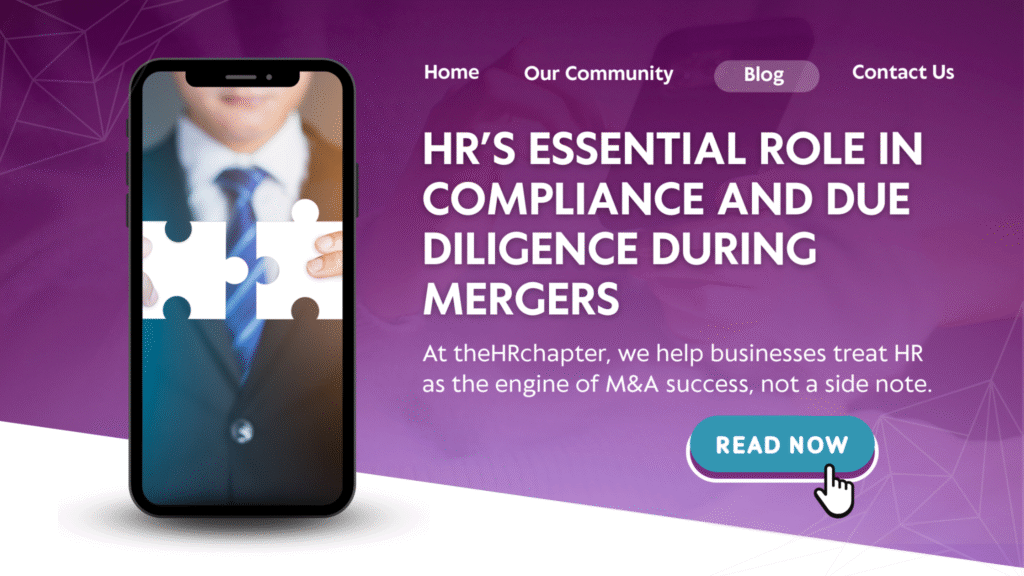The Strategic Role of HR in Mergers and Acquisitions: Driving Smooth Transitions and Employee Alignment

When two organizations come together through a merger or acquisition, the headlines often focus on the numbers: the deal size, the market share, the strategy. But behind those numbers are people. Real people, with hopes, fears, and identities tied to the work they do every day. And if we’ve learned anything about leadership, it’s that no matter how brilliant the strategy may be, it will falter if the people who carry it out are left behind.
That’s where Human Resources steps in. Not as an afterthought, but as a guiding force. In times of change, HR becomes the bridge between vision and reality, between uncertainty and clarity. It’s the function that helps employees feel seen and heard, even when the ground beneath them is shifting. And more than that, HR holds the power to align cultures, preserve trust, and inspire resilience making the difference between a merger that merely survives, and one that truly thrives.
Why HR is now mission-critical in M&A
In today’s world, dealmaking looks very different than it did just a few years ago. In 2025, we see fewer deals being made, but the stakes of each one are higher. Buyers are no longer chasing volume, they’re prioritizing quality, resilience, and long-term value. And that means the margin for error has narrowed. The real test isn’t just in making the deal, it’s in making the deal work.
- Growing people risks. Leadership effectiveness, talent scarcity, health costs, cyber threats, and AI require HR to integrate people risk planning throughout the M&A lifecycle.
- Integration and culture are critical. Over 60% of failed mergers stem from struggles in aligning people and culture, not strategy or finances.
- HR readiness is a gap. Two-thirds of HR leaders feel underprepared for M&A, citing weaknesses in due diligence, execution, and resources.
- Culture drives value. Actively managing culture boosts engagement and increases the likelihood of meeting cost and revenue targets; ignoring it risks losing value.
- Growing people risks. Leadership effectiveness, talent scarcity, health costs, cyber threats, and AI require HR to integrate people risk planning throughout the M&A lifecycle.
Strategic HR involvement in pre-merger planning
Before a deal closes, HR has a mission: to understand the talent landscape, anticipate risks, and lay the groundwork for clear communication. This isn’t a checklist exercise; it’s about building trust, aligning cultures, and ensuring that the integration journey begins with clarity and confidence.
Here’s how strategic HR involvement shapes the pre-merger phase:
| FOCUS AREA | HR’S ROLE |
| Talent Due Diligence | – Assess workforce capabilities, leadership strengths, and cultural fit. – Map critical talent, identify high performers, and analyze leadership pipelines to ensure continuity. |
| Risk Identification | – Review compliance and labor law issues, contractual obligations, unresolved disputes, union concerns, and dependencies on key employees. – Develop retention strategies to mitigate turnover risk. |
| Communication Planning | – Create transparent, audience-tailored communication strategies explaining deal rationale and changes. – Use two-way forums such as Q&A sessions and pulse surveys to address concerns and build engagement. |
When HR treats pre-merger planning as a strategic imperative, it transforms uncertainty into opportunity. By doing the hard work early, understanding talent strengths, mitigating risks, and setting up clear, honest communication; HR not only protects the deal’s integrity but begins building the foundation for a unified organization.
HR as a driver of cultural integration
Culture is the soul of an organization and in M&A, it can make or break the deal. Over 60% of failed mergers point to cultural misalignment as a key factor. Different values, work styles, and approaches to change aren’t abstract issues, they affect morale, trust, and retention.
Here’s how HR drives cultural integration:
1. Understanding the Cultural Clash Problem
– Recognize that cultural misalignment is a major driver of M&A failures.
– Identify differences in values, decision-making styles, and attitudes toward change that can create friction.
– Address these differences proactively to prevent resistance, disengagement, and turnover.
2. Harmonizing Values, Behaviors, and Work Practices
– Conduct a cultural gap analysis to map differences and synergies between organizations.
– Facilitate leadership workshops to co-create a shared vision and integration roadmap.
– Align policies, recognition systems, and day-to-day practices to reflect the new shared culture.
– Celebrate cross-company successes to build unity and reduce “us versus them” thinking.
3. Investing in Training, Workshops, and Leadership Modeling
– Design onboarding and cross-training programs to foster mutual understanding.
– Use leadership modeling sessions where leaders visibly embody the desired culture.
– Create interactive workshops that encourage teams to explore shared values and adopt common ways of working.
– Implement ongoing feedback mechanisms (such as pulse surveys) to track sentiment and adjust strategies.
When HR approaches culture as a deliberate, strategic focus, it transforms integration from a challenge into a powerful opportunity. Culture becomes the glue that binds organizations together, turning two companies into one with shared purpose, energy, and momentum.
Employee experience during the transition
In any merger or acquisition, success depends on how people experience the change. HR’s role is to turn uncertainty into trust and ensure employees stay informed, engaged, and aligned with the new organization’s mission.
- Pre-Signing: Build the people strategy early: assess leadership, culture, and retention risks to protect value before the deal closes.
- Pre-Close: Embed HR in the Integration Management Office, harmonize policies and rewards, and align leadership around a shared change story.
- Day 1–100: Deliver transparent communication, activate retention plans, and launch culture initiatives that unite employees and clarify direction.
- 6–18 Months: Finalize structure and systems, track engagement and performance, and continuously listen and adapt to sustain alignment.
When HR leads with empathy, clarity, and purpose, employees don’t just adapt to change, they become the driving force that makes the merger succeed.
Aligning organizational structures and policies
Aligning structures and policies isn’t about bureaucracy; it’s about fairness, transparency, and creating a sense of belonging across the newly combined organization. When HR leads with intention, it helps employees see consistency not as control, but as care, an assurance that everyone has a fair place in the new order.
To achieve this, HR must balance efficiency with empathy, standardizing where possible, yet honoring what’s unique in each legacy organization. The goal is one structure, one set of expectations, and one shared way of working that feels both equitable and inspiring.
| Focus Area | HR’s Strategic Role | Desired Outcome |
| Organizational Design | Streamline reporting lines, clarify spans and layers, and align decision rights to the new operating model. HR partners with leaders to ensure structure supports strategy and accountability. | A clear, agile organization that empowers decision-making and accelerates execution. |
| Policy and Rewards Harmonization | Audit and align compensation frameworks, benefits, job leveling, and performance management systems. Communicate changes transparently to minimize perceived inequities. | Consistent, fair treatment that preserves trust and prevents talent flight. |
| Cultural and Regional Balance | Standardize core policies globally while allowing flexibility for local labor laws, cultures, and employee needs. | A global organization that feels unified but locally grounded and respectful. |
| Change Enablement | Equip managers with toolkits, FAQs, and talking points to guide teams through structural and policy transitions. Provide training to help leaders model calm, fairness, and clarity. | Smooth adoption of new systems and behaviors, reinforced by confident, informed leadership. |
| Governance and Accountability | Establish clear ownership for policy compliance, workforce metrics, and decision-making processes. Integrate people data into governance dashboards. | Sustained alignment, transparency, and accountability across the merged enterprise. |
When HR thoughtfully harmonizes structures and policies, it does more than align systems, it builds trust. It tells every employee: you belong here, your work matters, and this new chapter has room for all of us. That’s how fairness becomes the foundation for unity, and how structure becomes a vehicle for shared success.
Post-merger HR strategy: Sustaining alignment and engagement
- Keep culture alive: Continue reinforcing shared values and behaviors through daily practices: onboarding, performance, recognition, and leadership modeling.
- Measure both people and performance: Track engagement, retention, inclusion, and productivity alongside financial synergies to ensure balanced success.
- Listen and adapt: Maintain continuous feedback through surveys and forums; respond quickly to signs of fatigue or misalignment.
- Invest in leadership: Develop leaders who communicate with empathy, clarity, and consistency to strengthen trust and inspire followership.
- Embed governance: Build structures that link people metrics to business goals, ensuring accountability for culture and engagement over time.
HR as the architect of unity and performance
The most successful integrations aren’t those that move fastest, they’re the ones that move together. HR’s strategic leadership ensures that culture, communication, and capability remain at the heart of every decision. That’s how value is realized, how engagement endures, and how new organizations emerge stronger than before.
If your organization is preparing for a merger or acquisition, now is the time to bring HR to the forefront. Partnering with theHRchapter can help you design and execute an integration strategy that protects your people, preserves your culture, and accelerates real, measurable value.
Because in every deal, there’s one truth we can’t ignore: when people thrive, the business follows.
Related Reads: Check out these other Articles!
HR’s Essential Role in Compliance and Due Diligence During Mergers
HR’s Essential Role in Compliance and Due Diligence During Mergers When we talk about mergers…
AI in Business Transformation: Moving Beyond the As-Is to the To-Be
AI in Business Transformation: Moving Beyond the As-Is to the To-Be Change is never easy….
Sustainable Business Strategies: Unlocking the Potential of AI in Business Transformation
Sustainable Business Strategies: Unlocking the Potential of AI in Business Transformation Too often, conversations about…



